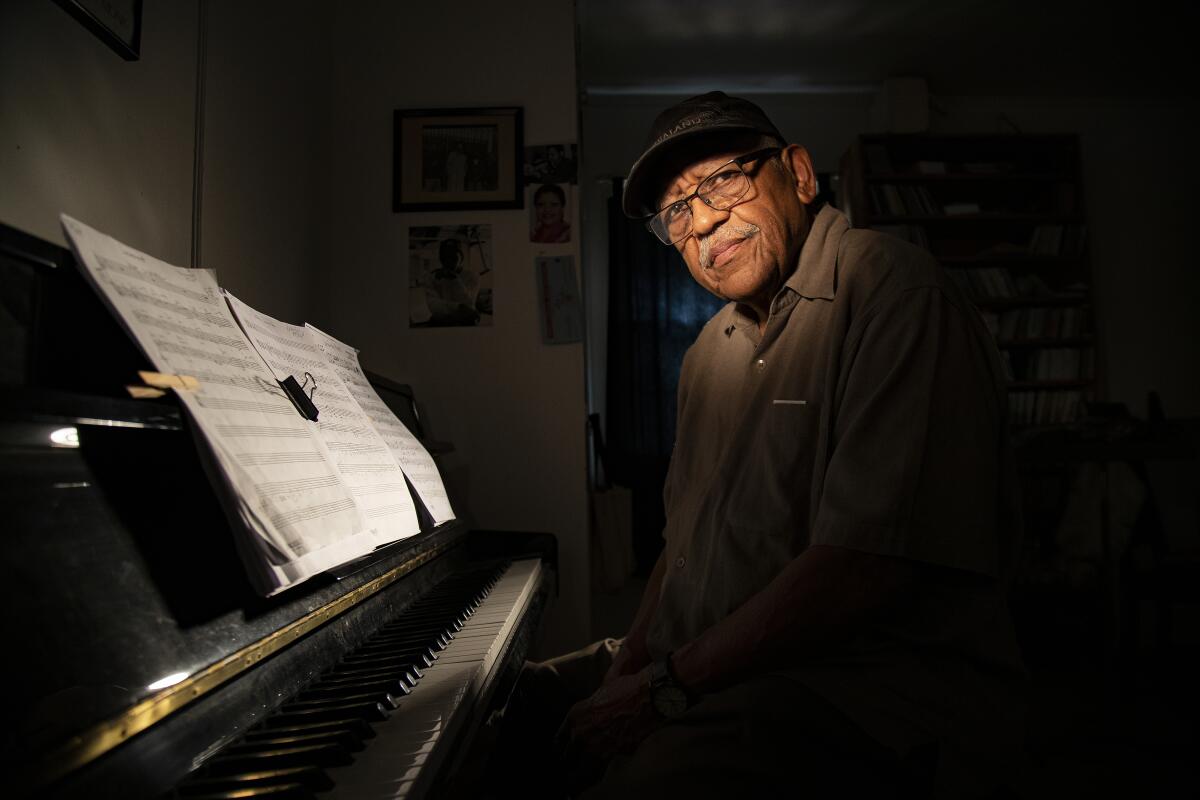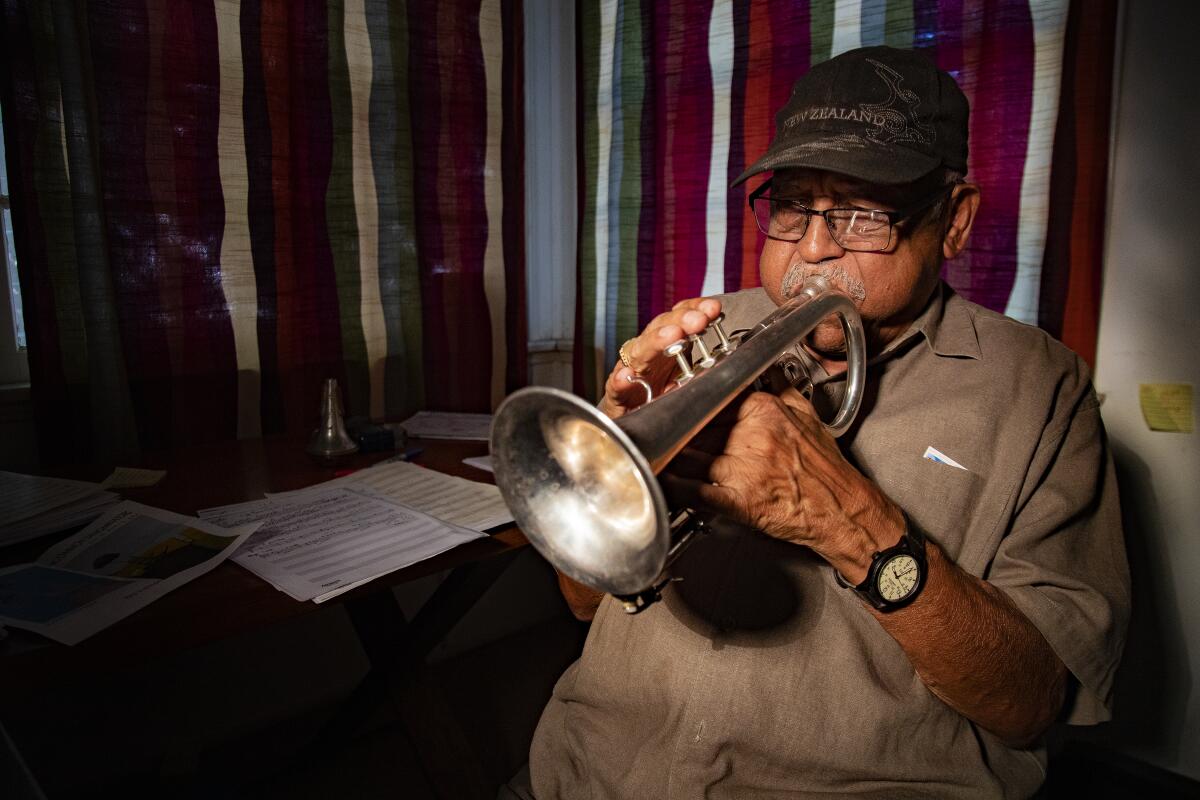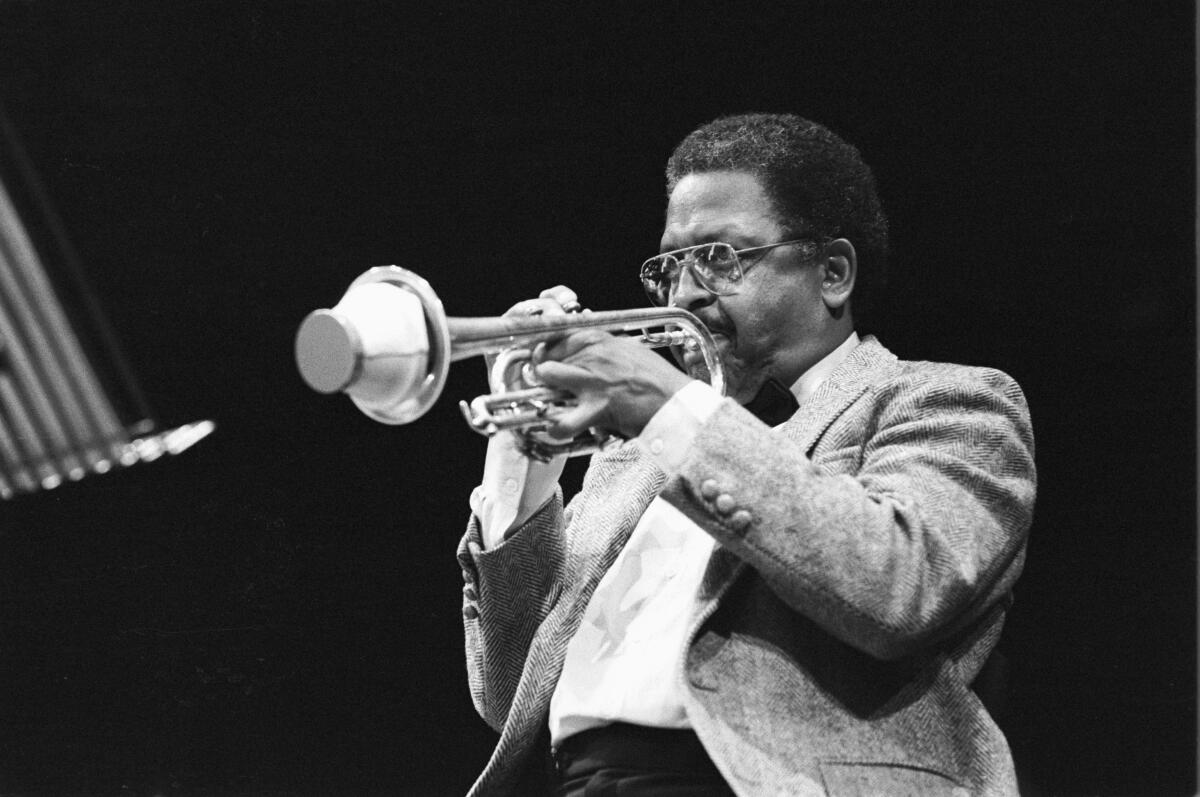An L.A. jazz legend pays homage to Jackie Robinson, with a pitch from a library assistant

- Share via
“You gettin’ this?” Bobby Bradford says gruffly. “You see how this thing works, man?”
A bunch of musicians are kicking back on an Altadena patio. It’s a Sunday night after rehearsal assembled by trumpeter, cornetist, composer and bandleader Bradford. And now, as instruments are put away, Bradford settles into some outdoor furniture and starts explaining things, like the sage and teacher that he is.
The accomplished and diverse seven members of this ensemble have been working on a suite of Bradford’s compositions, “Stealin’ Home,” dedicated to the life of baseball player Jackie Robinson. The music is commissioned by a Pasadena-based nonprofit art organization, the Baseball Reliquary. Robinson grew up in Pasadena, and Bradford’s band will be performing “Stealin’ Home” in Pasadena four times between now and the end of the year (including once on the eve of the World Series) as part of a national centennial celebration of Robinson’s birth.
Bradford has been here so long, and so solidly does his work, that in classic Los Angeles style people take him for granted. But he was standing beside Ornette Coleman at the birth of free jazz, the movement shaped here in the 1950s by musicians breaking open chord and song structures to follow their finely honed impulses. A decade later, it changed jazz everywhere. Heck, as is detailed in an upcoming book by Matthew Duersten, he and Coleman once worked side by side in blue aprons at the downtown Bullock’s stockroom when they weren’t onstage.
Along with being a world jazz beacon, Bradford is a revered professor of jazz history and improvisation who has educated generations of local players; he has taught at Pomona College since 1975 and taught for 30-plus years at Pasadena City College. He lives in Altadena with his second wife and he has four children from two marriages.
It’s a Sunday night, the sun is down and the bugs are coming out. And along with the skeeters, so comes the wisdom, and it too has bite. Because Bradford is holding court, and soon members of the band, male and female, white and black, spanning 50 years, have their phones out, recording his words. Because this 85-year-old knows stuff, and you have to make the most of it when Bradford is chopping it up.
He offers a rendition of the only way you can compliment a woman at Pomona College these days on her dress (robotically, he explains) and describes seeing minstrel shows in Mississippi as a youth. He talks about Jim Crow he encountered as a college student in Texas and how much money parents pay today to get their kids into college. “It’s pretty clear by this lady who just got sent to jail for 14 days that if the kid’s not up to snuff you got to make it happen … if you want your kid to be a member of that ‘other’ group.”
Every once in awhile, when he’s satisfied that he has expressed exactly what he has been trying to say, he looks over and signals it’s time for the interviewer to lob another.
OK. “These days,” I inquire, “do your students even know who Jackie Robinson was?”
Bradford has asked them. “Yeah — but only as a name in black history.“ They know him as a name on a list, but not an organic bridge from the days of Jim Crow to the days of Obama and Kaepernick.
“Two black kids said, ‘We know he was a famous athlete.’” But that was the extent of it. There was no knowledge that Robinson broke baseball’s “color line,” integrating a sport that had been off-limits to African Americans until Robinson joined the Brooklyn Dodgers in 1947. And no awareness of the pressures Robinson kept to himself, the wall of hate he threw himself at.
“See, they thought the only reason we weren’t in the major leagues was we couldn’t play as well as the white boys,” Bradford says. He stares ahead for a second. “I said to them, ‘A stick and a ball? And you run and jump? And you think these Negroes can’t hit a ball and run and catch it? Where you been?’”
Bobby Bradford was 11 the first time he came to L.A. He was born in Cleveland, Miss., in 1934, and he arrived with his mom and stepfather while they were looking for work in the factories booming during World War II. Booming so much, in fact, that they didn’t mind hiring black workers who were streaming in from all over the South.
Bradford’s family settled in a neighborhood called Bishop Heights, a place that would become known more widely as Chavez Ravine — where Dodger Stadium is today. But in 1945 the Dodgers were still back East, and while they weren’t packing yet, they were planning profound changes that reached far beyond baseball.
That story’s been told, of course. How when Robinson was called in to meet with Dodgers president Branch Rickey, he was given a taste of the contempt he was sure to feel on the way up the minor league ladder, the slurs sure to come from the players and fans, should the Dodgers give him a contract.
“Turning the other cheek” became the cliché regarding how Robinson survived breaking the color line, but maybe “keep your mask close by” says it better. The backyard talk in Altadena moves on from Robinson to someone else Bradford calls a “hero,” trumpeter Louis Armstrong.
“I didn’t read this in Life magazine. I was there,” declares Bradford. “He had a mask he wore when he was in the company of white people, different than he’d have in a room full of black people. Listen, I’ve been in a room with Louis Armstrong when he’s shooting craps, when he‘s putting pomade in his hair and putting a towel over his head.” It was in the 1940s, when he was a high school student in Dallas. “That’s all part of it,” he says. “And there’s no point in sweeping this stuff under the rug.”
The masks are everywhere, then and now, he adds. He’s talking about all the stuff — rage, for sure, but also the blues and informality and dice and more — that had to be hidden by the barrier-breakers for fear of how it would look to the masses. Progress is ongoing, he says as he gets up. “But somebody had to make a move, like Jackie.”

The Baseball Reliquary is a Cooperstown of the mind. It exists most of all in the imagination. The rest of it is to be found in Pasadena.
Terry Cannon slides into a seat at a coffeehouse late one morning and explains the project. He is a 66-year-old assistant at Pasadena’s Allendale Branch Library. Cannon started the Baseball Reliquary in the late 1990s; he has an arts background and is a passionate baseball fan.
“I was looking to create some sort of an organizational structure to meld baseball and the arts,” he says as if that explains anything. What he came up with was a sort of fraternal society that bowed down to the magic of the game and also to its power to change society.
If some museums have busts and bronzes and plaques, the Reliquary has a collection that includes a partially digested hot dog Babe Ruth once gobbled, a jockstrap worn by the 3-foot, 7-inch tall pinch hitter Eddie Gaedel, and a mosaic rendering of slugger Dave Winfield made of thousands of pieces of chewed bubblegum. Exhibitions are mounted in libraries and other cultural intersections in Southern California. A nonprofit that survives most of all on an annual grant from the county arts commission, the Baseball Reliquary each year inducts three figures — athletes and others — into the Shrine of the Eternals, a way of paying tribute to good human beings and unusual stories that define their beloved game.
Last year Cannon decided to commission Bradford to write music that would pay tribute to Robinson. The founder of the Baseball Reliquary has known the musician for a long time. In the 1970s Cannon edited an underground newspaper that covered the Pasadena jazz scene, and Bradford was running a jazz club for a few years called the Little Big Horn, where students of his like the flutist James Newton and friends like clarinetist John Carter, woodwind player Vinny Golia (now in Bradford’s band) and singer Diamanda Galas participated in jam sessions.
Cannon decided last year to pitch his commission to Bradford, and then a funny thing happened: “Life intervened” is how he puts it. Just when he was turning 65, Cannon got jaundiced and discovered he had cancer of the bile duct.
He was headed for complicated surgery, and as he prepared himself he ran into Bradford at their local bank. “I said, ‘If I survive the surgery are you interested in doing this project?’ And as soon as I briefly explained the idea, I could see him already thinking about it, imagining how he might do it.”
Cannon came out of the 11 hours of surgery better than he went in, and Bradford finished the music over last summer.

The “Stealin’ Home” suite features four pieces that touch on a variety of styles. “Second Lieutenant Jackie Robinson” is a martial soul number in the vein of Bobby Timmons’ “Blues March,” and the tuba and standup bass tandem in the band gives “O for 3” a funky bottom, the kind that has reverberated in the music of many of Bradford’s students. Another piece, Bradford says, was partly inspired by a song about Robinson he once heard Cab Calloway sing. If this sounds like a whole lot of jazz history filtered through one man’s mind, that’s what it is, and played by some of the finest musicians performing in town these days.
At a recent show at the Santa Monica Public Library, Bradford’s band tested several of the new compositions. They sounded loose, amorphous and full of life.
Late in the set, a listener called out for the jazz standard “Body and Soul.” Bradford gently acknowledged the request, and then somebody else in the crowd added an addendum: “Play the Coltrane version!” If he suddenly felt he was in a wedding band, he didn’t immediately let on.
Bradford was intense but calm in his response. He talked about how he could play it in the style of a chain of great trumpeters, from Louis Armstrong onward, and noted how it had taken him years to understand what each was doing. Then the kicker, the dismissal of the request wrapped in a teachable moment: “Now, you see, I been working all my life to play the Bobby Bradford version.” He offered it with a smile.
It wasn’t the Louis Armstrong smile or the all-in Jackie Robinson grin. No doubt Bradford’s got his mask too. But after 60-plus years of playing and teaching in Los Angeles, he has reached an age at which he doesn’t have to turn the other cheek.
'Stealin' Home'
Sept. 29, Westerbeck Recital Hall, Pasadena City College, Pasadena
Oct. 21, Crawford Family Forum, 474 S. Raymond Ave., Pasadena
Nov. 17, Boston Court Pasadena, 70 N. Mentor Ave., Pasadena
Dec. 15, Robinson Park, 1081 N. Fair Oaks Ave., Pasadena
All events are free. Info at baseballreliquary.org/events.
More to Read
The biggest entertainment stories
Get our big stories about Hollywood, film, television, music, arts, culture and more right in your inbox as soon as they publish.
You may occasionally receive promotional content from the Los Angeles Times.










